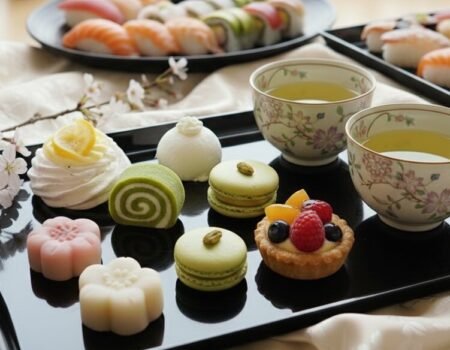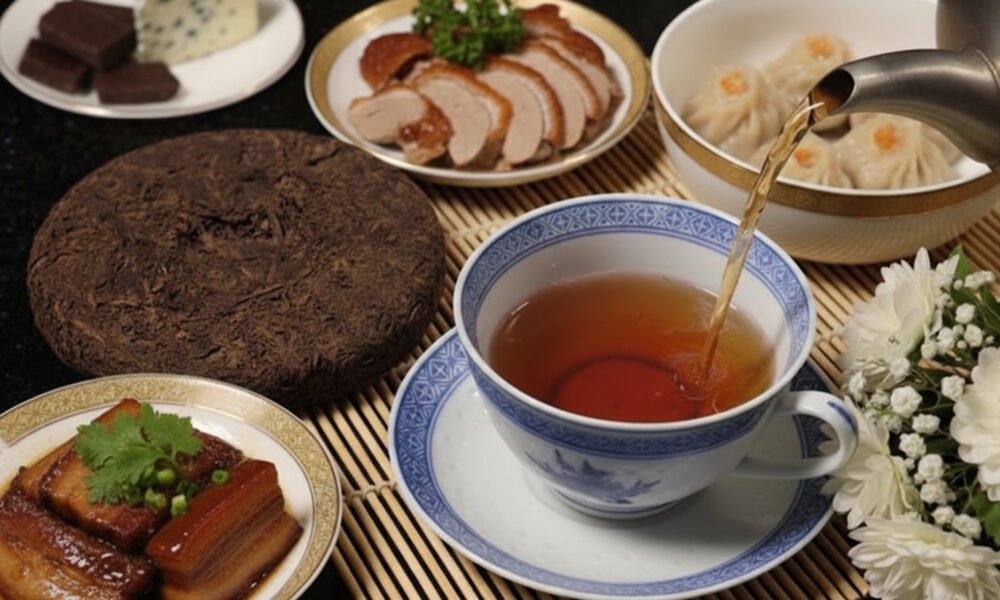
Ultimate Guide to Pu-erh Tea Food Pairing: Best Tips for Pairing Pu-erh Tea with Food
Index
This earthy, fermented tea from Yunnan Province of China has this almost magical ability to cut through rich oils and balance bold flavors.
This guide will show you simple ways to match this tea with everything from dim sum to dark chocolate, and how it can easily elevate your next meal.
Key Takeaways
- Pu-erh tea, famous for its earthy and fermented notes, pairs best with rich meats like duck or pork belly by cutting through heavy oils and balancing strong flavors.
- Ripe (shou) Pu-erh never turns bitter and is ideal alongside oily dim sum, fried foods, roasted meats, aged cheeses such as cheddar or Gouda, and dark chocolate with 70%+ cocoa content.
- Scientific studies show that pu-erh’s fermentation produces up to 24 key volatile organic compounds (VOCs), supporting digestion by helping fats metabolize efficiently after fatty meals.
- Both raw (sheng) and aged Pu-erhs pair well across a wide range of dishes—pair young varieties with spicy food and seafood; use older teas for bold proteins or nutty desserts.
- Experts recommend discarding the first brew to reduce mycotoxins like asperglaucide; always serve at moderate temperatures and adjust steeping times to avoid overpowering lighter fare.
What Are the Flavor Characteristics of Pu-erh Tea?
Pu-erh tea has deep, earthy flavors and a savory taste that sets it apart from black tea or green varieties.
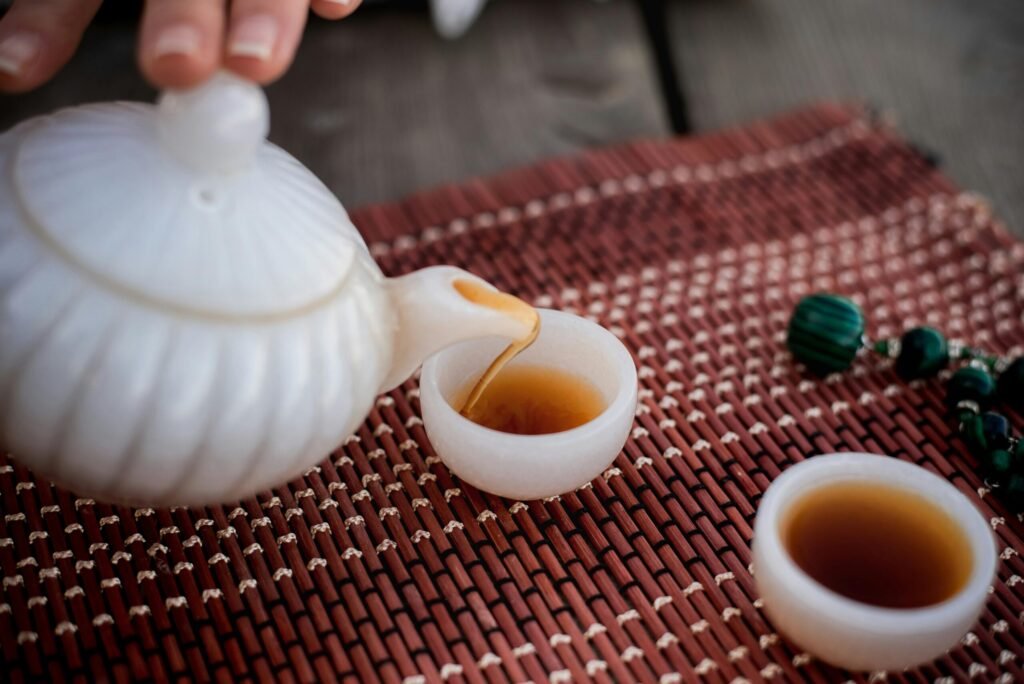
These complex flavors invite you to explore how pu-erh pairs with different foods and desserts.
Earthy and Woody Notes
Raw pu-erh tea offers a fresh, mellow flavor that often reminds drinkers of spring lawns and damp autumn leaves. You’ll notice woody or smoky hints in each brew, with some detecting notes of tobacco or wild mushrooms.
Reddish-brown in color, the tea delivers mild bitterness balanced by subtle sweetness as the infusion cools on your tongue.
Older varieties from Yunnan province turn darker than black tea. They release a fuller aroma similar to forests after rain.
Ripened pu-erh brings stronger earthy tones that are especially pronounced due to its unique fermentation. “Pu-erh’s complexities often make you stop and consider its journey,” notes Tony Gebely of The Phoenix Collection, a California tea purveyor.
These earthy flavors give structure to pairings with rich meat dishes, roasted vegetables, and dim sum oils. They help cleanse your palate between bites while highlighting umami-rich foods.
The complex flavors change over time because fermentation deepens both earthiness and woodiness year after year. Experienced tasters will savor the lingering mouthfeel and seek teas where this natural richness stands out without overpowering lighter food pairings such as steamed buns or dumplings.
Fermented and Complex Profiles
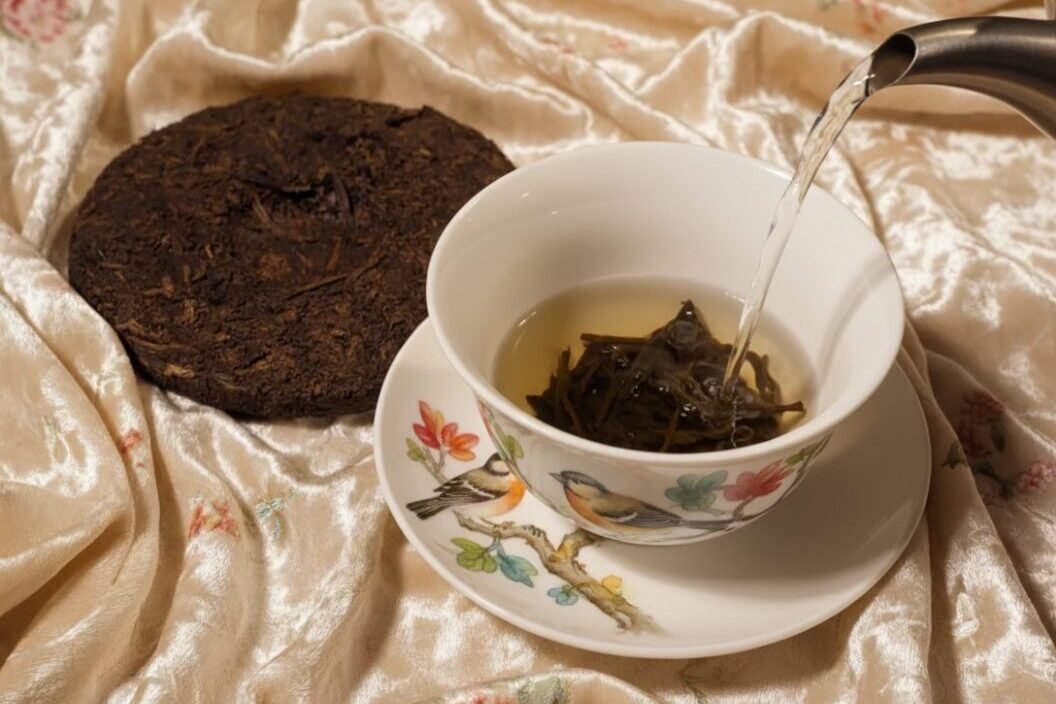
Microbial fermentation shapes the unique taste of pu-erh tea. This process takes place under humid conditions in Yunnan Province, China.
The aging is not rushed. Years can pass before the flavor reaches its full depth.
During this time, 24 key volatile organic compounds (VOCs) form and change. Among them, 1,2,3-trimethoxybenzene stands out for its strong effect on aroma.
The sixth pile turning stage marks an important point for ripe Pu’erh’s signature notes. Here, Monascus purpureus (MPT) develops crucial flavors that many describe as earthy or wine-like.
Experts group the metabolic pathways of 22 major VOCs into five main types during this stage. These changes make each cup more than a drink.
It brings layered flavors: earthiness like damp forest floor, hints of tart fruit or citrus peel, even sweet notes from long aging similar to dark chocolate or dried berries.

Pu-erh’s evolving complexity allows it to stand up to rich foods and bold cheeses. This highlights why pairing with pu-erh creates harmonious meals within Chinese cuisine, balancing fatty acids in duck or pork belly while cleaning your palate between bites.
Digestive Properties
A shift from the fermented and complex profiles of pu-erh tea brings attention to its prized digestive properties.
Pu-erh contains higher levels of polyphenols, catechins, flavonoids, and caffeine compared to most other teas. Its fermentation encourages beneficial fungi and bacteria that might support gut health by diversifying the microbial community in the stomach.
You’ll appreciate pu-erh’s traditional role after rich meals; Chinese medicine has long valued its digestive properties. While studies show pu-erh can help regulate fat metabolism and reduce lipid accumulation, robust human evidence for direct reduction of fat digestion is however limited.
It’s best to rinse aged pu-erh to remove storage dust and possible debris—a simple precaution that ensures the cleanest taste. For optimal results, you’ll want to enjoy your cup about 30 minutes after heavy meals.
This simple step adds safety while still enjoying all digestive benefits paired with pu-erh tea.
How Does Pu-erh Type Affect Food Pairing?
Pu-erh tea types influence how flavors match with food and which dishes pair well with the tea.
Each style offers unique notes that enhance or balance different meals.
Raw Pu-erh Food Pairing
Raw (sheng) Pu-erh shines with its fresh, mellow, and sometimes astringent character. This type pairs well with foods that highlight or balance these qualities.
Bold & Savory Pairings
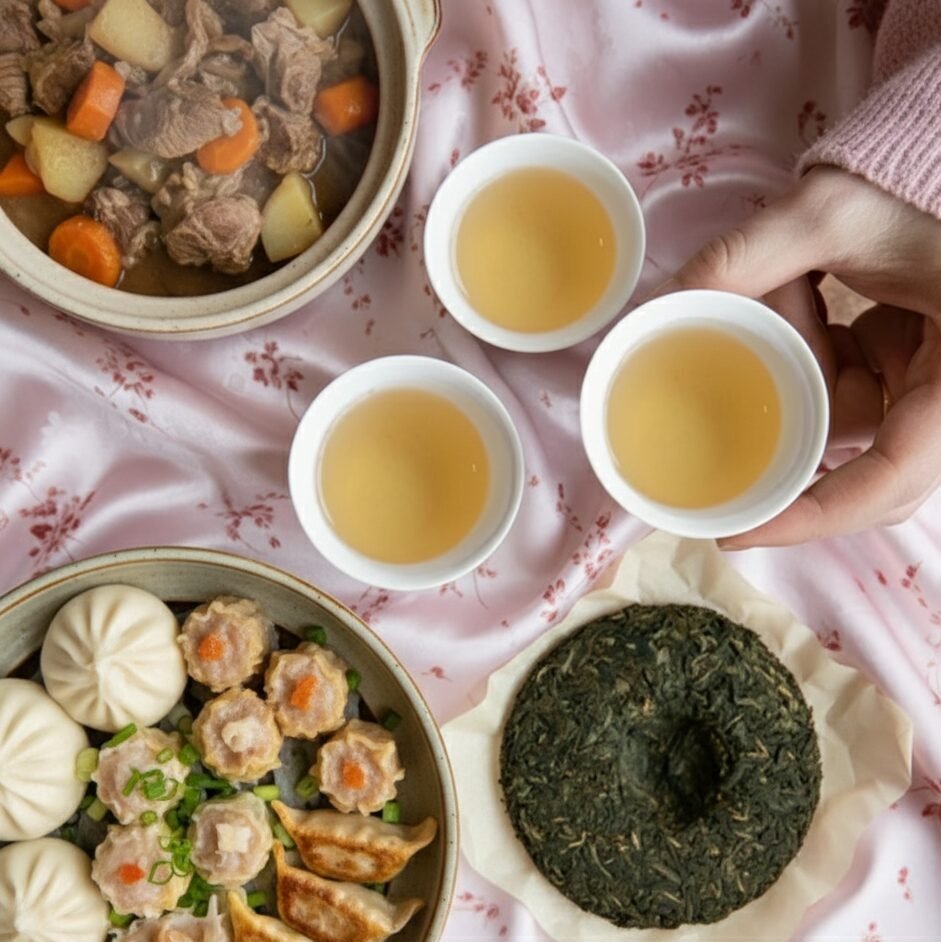
For Rich, Spicy, and Oily Dishes:
- Spicy cuisines – Young raw Pu-erh balances the heat in Indian curry or chili noodles with its natural astringency
- Dim sum and dumplings – Well-brewed raw Pu-erh cuts through lingering oils while its phenolic content cleanses your palate
- Grilled seafood – Young sheng from Yunnan Province matches fire-roasted qualities with its earthy notes
- Peking duck – Adjust steeping time carefully to draw out antioxidants without overpowering the duck’s savory richness
Light & Harmonious Pairings
For Subtle Foods Where Both Flavors Shine:
- Chinese staples – Lighter foods like steamed fish, mantou (steamed bread), or rice create harmony with the tea
- Seafood sushi – Raw Pu-erh echoes sushi’s clean mouthfeel while adding earthy, wine-like aromatics
- Soft textures – Steamed eggs or walnut-topped bread complement the tea’s subtle astringent edge
Sweet & Contrasting Pairings
For Desserts and Cheese:
- Chocolate indulgence – Floral raw Pu-erh varieties create exciting contrast with dark chocolate truffles, caramel, or rich ganache
- Berry desserts – Sugar-dusted berries lift up wildflower aromas in bright raw Pu-erh infusions through their tart acidity
- Aged cheeses – Older raw Pu-erh creates gentle interplay with aged Cheddar or mild Gouda, balancing creamy richness with woody tea complexity
These combinations work best at moderate temperatures. They can open doors to true sensory exploration during any tea session or meal pairing it with food.
Ripe Pu-erh Food Pairing
Ripe Pu-erh tea, also called shou Pu’er, offers an earthy and mushroom-like taste profile. This tea never turns bitter, making it flexible for pairing with rich and flavorful foods.
Rich & Fatty Food Pairings
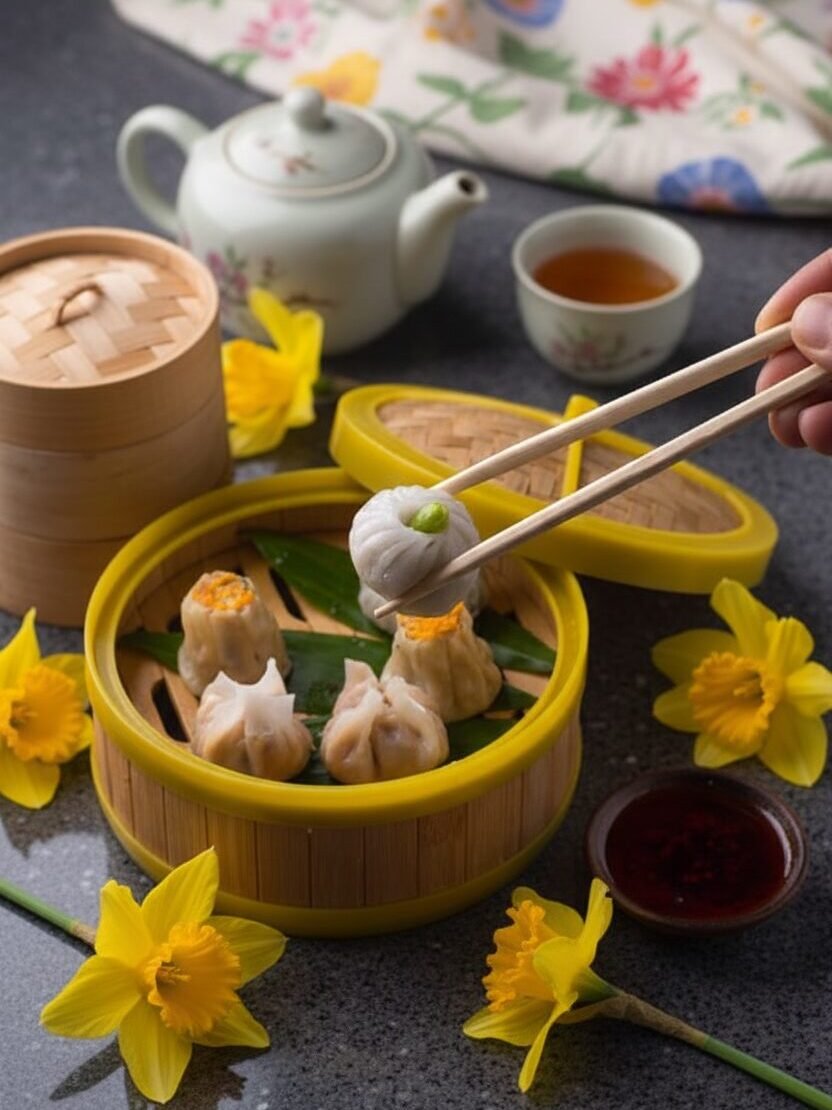
For Cutting Through Heavy Dishes:
- Roasted meats – Ripe Pu-erh balances strong flavors while cutting through the fattiness of pork belly or duck with its earthy notes
- Dim sum – Traditional teahouses in China recommend ripe Pu-erh to wash lingering oils from your palate during dim sum meals
- Fried foods – Pair with tempura or spring rolls to cleanse oil-heavy sauces from your mouth between bites while boosting digestion
Fermented & Aged Pairings
For Complex Flavor Enhancement:
- Cured meats – The tea’s fermented complexity elevates umami flavors found in aged proteins like cured sausages
- Strong cheeses – Aged cheddar or blue cheese match ripe Pu-erh’s boldness without their richness overpowering the tea’s deep flavor
Earthy & Umami Combinations
For Harmonious Flavor Matching:
- Mushroom dishes – Both share earthy undertones that complement each other beautifully
- Stir-fries with dark soy sauce – The tea’s depth echoes the savory complexity of soy-based dishes
Dessert Pairing
For Sweet Endings:
- Dark chocolate – High cocoa content chocolates blend perfectly with ripe Pu-erh; both contain antioxidants and their bitterness levels harmonize without clashing
Aged versions of pu-erh bring even greater depth and open up new options for food pairings in exciting ways.
Aged Pu-erh Considerations
Shifting from ripe Pu’er tea’s mellow nature, aged Pu-erh brings even deeper flavors to your tea and food pairing experience.
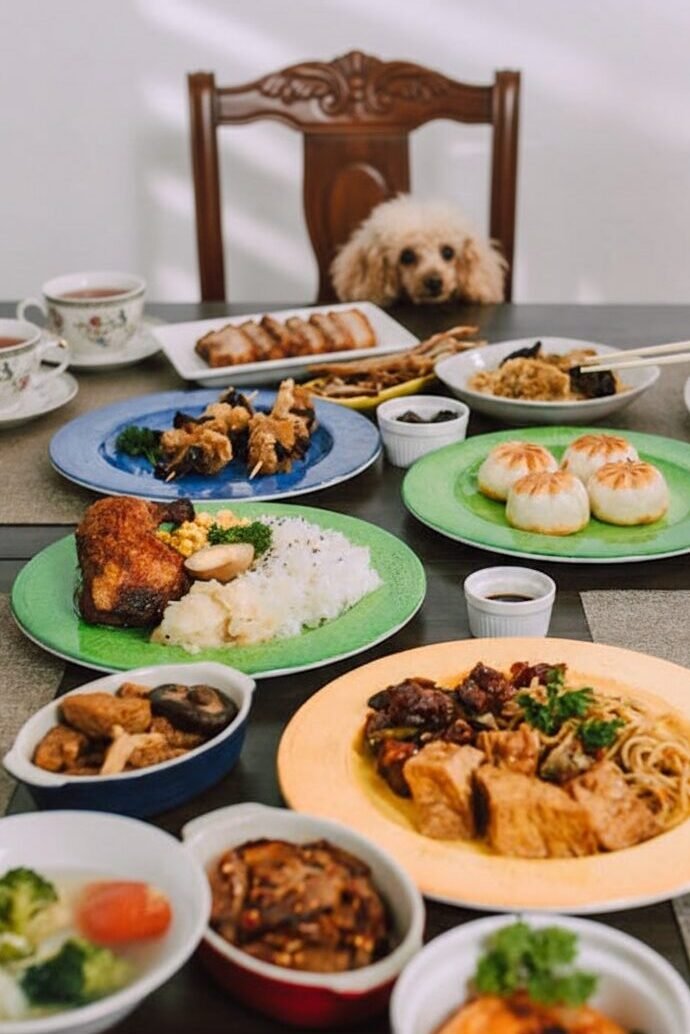
Its maturity over years creates a complex profile that can elevate a variety of dishes.
Rich & Savory Pairings
For Heavy, Flavorful Dishes:
- Rich meats – Aged Pu-erh cuts through heavy flavors and balances oils in duck, lamb, or beef stew with its earthy taste
- Mushroom and truffle dishes – The woody character complements these foods while highlighting their umami qualities
- Greasy dim sum or fried items – The tea’s fermentation maintains digestive properties that wash away lingering oils and refresh your palate
Brewing for Food Pairing
Optimal Preparation Methods:
- Higher temperatures – Brew at 205-212°F (96-100°C) to draw out full depth and enhance interaction with savory foods
- Extended steeping – Use longer steeping times when serving strong cheeses like blue cheese or aged cheddar
- Multiple infusions – Each steep reveals new layers that interact uniquely with changing plates throughout your meal
Sweet & Versatile Pairings
For Diverse Menu Options:
- Dark chocolate – High cocoa content matches the tea’s fermented notes while amplifying both flavor profiles
- Nut-based treats – Aged Pu-erh handles both sweet desserts and hearty proteins with equal grace
Pairing Principles
Strategic Matching Guidelines:
- Balance intensity – Match powerful dishes with robust teas, but avoid overpowering subtle foods like steamed white fish or mild crackers
- Build your collection – Include several vintages; older years pair best with deeply-flavored foods while younger aged options blend well with lighter fare
Through careful selection, brewing technique, and mindful pairing choices using these guidelines, you can amplify every meal shared with aged Pu-erh tea’s one-of-a-kind qualities.
What Foods Pair Best with Pu-erh Tea?
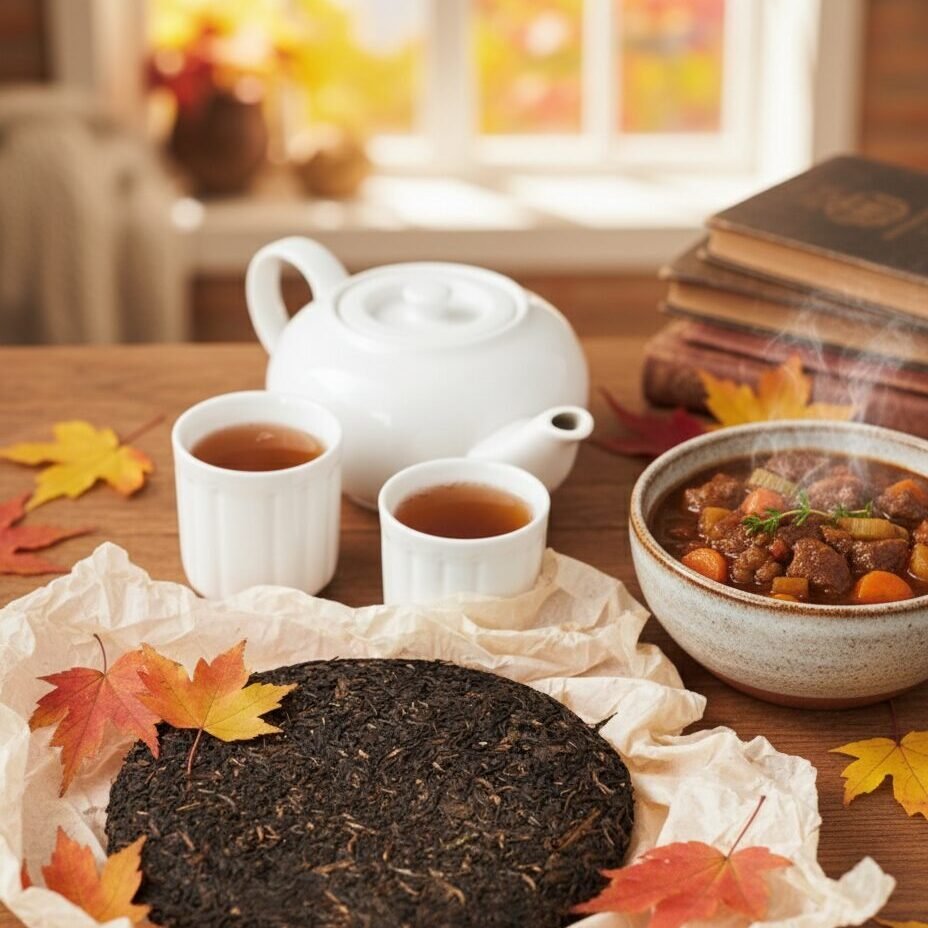
Pu-erh tea pairs well with a variety of foods, so read on to discover inspired combinations that highlight its earthy character.
Pu-erh with Rich and Fatty Foods
Steaming and roasting bring out the best in fatty foods, yet heavy oils can linger on your palate.
Many tea drinkers choose Pu’er tea to wash the lingering dim sum flavors and clear away dim sum oils from dumplings, pork buns, or even mooncake. The earthy and woody notes in ripe Pu-erh cut through fat from roasted meats like duck, pork belly, or lamb.
You will notice that each sip of this tea balances the richness of these dishes.
Aged cheese pairs well with Pu-erh too. Cheddar’s sharpness highlights the tea’s smooth side while helping cleanse any remaining fat.
Spicy Indian cuisine and strong Sichuan dishes also go very well with Pu-erh as it aids digestion after fatty meals. Some people compare its effect to coffee due to its phenolic content in tea leaves which helps stimulate norepinephrine release during a meal or after exercise.
Savoring dark chocolate with a high cocoa percentage further shows how this bold Chinese favorite stands up beyond Chinese favorites, enhancing both food and drink at once.
Pu-erh with Aged Proteins

Aged proteins, such as dry-aged beef or air-dried duck breast, match well with Pu-erh tea’s earthy and layered flavors.
The complex notes of a 5 to 10-year-old Pu-erh highlight the savory richness found in venison, lamb, or wild boar. Each sip of dark fermented tea helps balance the gamey taste that often defines these meats while warming the palate and enhancing umami.
Many chefs recommend pairing aged Pu-erh with prosciutto or bresaola during special meals.
Roasted meats benefit from this match too. A slice of fatty pork belly shows greater depth when enjoyed alongside ripe Pu-erh, which cuts through residual oils and refreshes your palate between bites.
Those who serve duck confit at home discover how each cup brings out the best in both protein and tea. This partnership is similar to pairing whisky with cured meats.
Both drinks offer full-bodied tastes that stand up to strong flavors. Cheese also enters the conversation soon after discussing proteins since many find that certain types share aging processes and flavor notes with these teas.
Pu-erh with Strong Cheeses

Pu-erh tea brings out deeper flavors in strong cheeses like sharp cheddar, blue cheese, and aged Gouda.
Its earthy notes and tannins help cut through the richness, allowing nutty or funky cheese aromas to shine. Pairing Pu-erh with a wedge of Gouda and a cracker makes both taste more intense and satisfying.
This tea works well even with cheese blends that include roasted nuts or caramelized almond crusts. The pairing surprises many because most people expect wine instead of tea at the cheese board.
Pu-erh’s fermented complexity stands up to bold dairy flavors better than lighter teas such as Darjeeling. Enjoy rich types of chocolate next to your cheese plate for an extra flavor layer.
The tea ties together the fullness of both the cheese and the chocolate without overwhelming them.
Pu-erh with Chocolate

After exploring strong cheeses, richer desserts shine with the earthy notes of Pu-erh tea.
Dark chocolate, especially with 70% or higher cocoa content, matches aged Pu-erh nicely to balance the bitterness and smooth out any sharp edges found in both the tea and the chocolate. Ripe types bring out fruity or nutty flavors from chocolates that include fruit pieces or chopped nuts.
Raw styles complement ganache fillings and gooey truffles by brightening their dense sweetness without overpowering them.
Flavored varieties such as orange- or mint-infused bars can open new dimensions for anyone who enjoys experimenting in baking or candy treats. A small cracker on the side adds crunch that contrasts well against creamy chocolate textures, letting each element stand out clearly.
How Does Pu-erh Cut Through Fatty Foods?
Pu-erh tea goes straight to work and quickly refreshes your palate after each rich bite.
The earthy flavors of the tea stand strong beside dim sum oils and heavy roasted meats, making every new taste sharper and more enjoyable.
Pu-erh with Dim Sum
Pu-erh tea pairs perfectly with dim sum, thanks to its deep flavor and unique digestive effects.
The tea is known for cutting through dim sum oils and heavy dishes.

Classic Dim Sum Pairings
Traditional Combinations:
- Pork buns and shrimp dumplings – Pu-erh balances the meal and reduces the greasy feel left by these favorites
- Spring rolls and fried taro cakes – The slightly fermented taste of pu-erh complements these common dim sum dishes
- Sticky rice, barbecue pork, and bean curd rolls – Traditional Cantonese meals serve dark-aged pu-erh alongside these platters
Tea Selection & Preparation
Expert Recommendations:
- Ripe pu-erh preference – Experts recommend ripe pu-erh for its rounder, earthier flavor that stands up to bold fillings
- Hong Kong style – Many teahouses blend pu-erh with chrysanthemum flowers to soften strong flavors and aid digestion
Digestive Benefits
Health & Science:
- Fat metabolism – Scientific studies from 2022 show pu-erh’s fermentation produces compounds that help fats metabolize more efficiently after eating. Fermentation leads to compounds that aid fat/lipid metabolism, mainly in animal studies; human effects plausible but not directly as “efficient fat metabolizers”.
- Palate cleansing – Sipping hot pu-erh between bites cleanses your palate so you can enjoy each new dish without lingering oiliness
- Balanced dining – The tea-food balance allows you to experience every bite without feeling weighed down by richness
Pu-erh with Roasted Meats
Pairing pu-erh tea with roasted meats creates a flavorful balance that enhances both the food and the drink.

The tea’s earthy depth and slight bitterness work well with rich, fatty cuts.
Meat Pairing Fundamentals
Fat-Cutting Properties:
- Rich meats – Ripe pu-erh balances the richness of duck, pork, or lamb while cutting through fat and cleansing your palate
- Fat metabolism – Tea antioxidants support fat metabolism, making it ideal for fatty dishes
- Roasted duck – The tea’s bitterness refreshes your mouth between bites of this rich poultry
Cooking Method Matches
Temperature & Technique Pairings:
- High heat and slow-roasted meats – Aged pu-erh’s fermented notes match beautifully with meats cooked using these methods
- Grilled and smoked dishes – The bold character stands up to grilled lamb chops or pork belly without being overwhelmed by smoke or seasoning
Dining Experience Enhancement
Traditional Service & Variations:
- Chinese restaurant tradition – Restaurants often serve pu-erh alongside hearty roast platters as it enhances flavor contrast
- Floral blend option – Try ripe pu-erh blended with chrysanthemum flowers to introduce floral notes when eating spiced or herb-crusted meats
This foundation sets up exciting pairings with other Chinese dishes such as Peking Duck and braised specialties.
Pu-erh with Fried Foods
Pu-erh tea shines when paired with fried foods.
Its earthy, fermented notes and digestive properties offer a satisfying counterbalance to oil-rich dishes.Grease-Cutting Properties
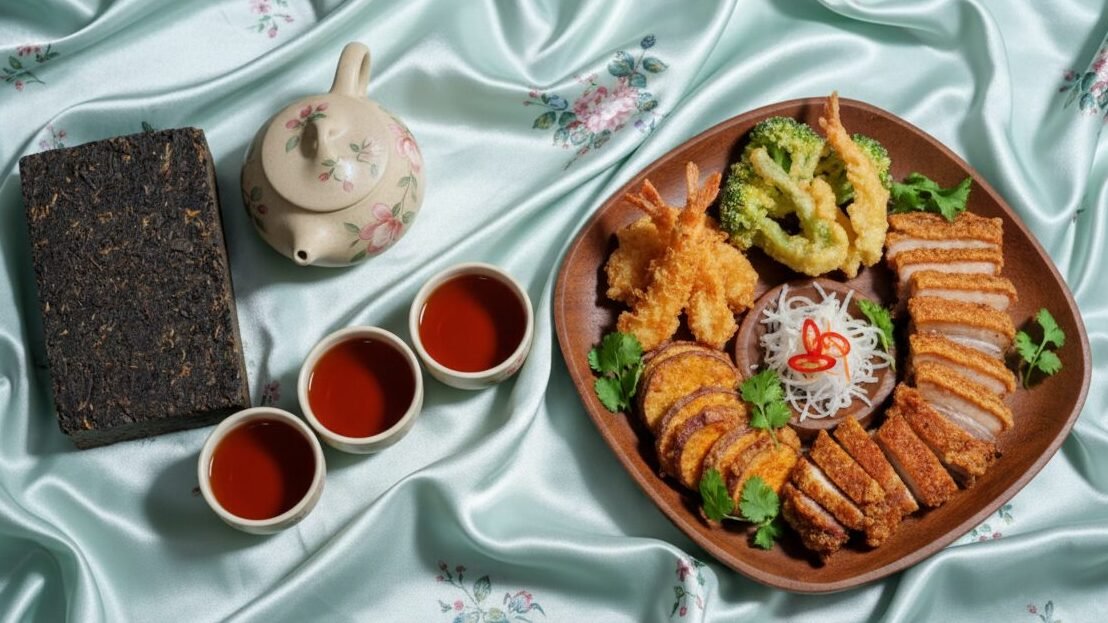
Digestive Benefits:
- Fried dim sum – The slight fermentation in Pu-erh cuts through greasiness while enhancing both flavor and digestion
- Palate refreshing – Tea researchers recommend pairing dim sum with Pu-erh because it refreshes your palate after each bite
- Fat metabolism – The digestive boost aids in fat metabolism, easing the sensation of heaviness from fried meals
Specific Fried Food Matches
Perfect Pairings:
- Crispy pork belly or tempura – Drink ripe Pu-erh alongside these dishes; the tea’s deep profile balances heavy, fatty bites
- Nut-based fried snacks – Sipping Pu-erh highlights subtle flavors often hidden under oil through its complexity
- Chinese spring rolls or southern-style chicken – Choose aged Pu-erh for these richer, layered fried foods; its earthiness brings depth to every mouthful
Tea Selection Guidelines
What Works (and What Doesn’t):
Avoid lighter teas – Darjeeling tea and similar light varieties lack the body needed to match the richness of fried food

What Chinese Dishes Go Best with Pu-erh?
Pu-erh tea enhances a range of classic Chinese dishes in unique ways.
Read further to see which meals earn top marks for pairing.
Pu-erh with Peking Duck
The earthy and rich flavor profile of Pu-erh tea amplifies the indulgent flavors found in Peking duck.
Slices of tender duck, crisp skin lacquered with sweet sauce, and soft steamed rolls create a decadent combination. A cup of well-brewed ripe or aged Pu-erh brings out the savory layers hidden within each bite.
Tannins in the tea gently cleanse your palate without overpowering the delicate aroma of five-spice.
This pairing does more than highlight taste. It also serves a purpose at the table.
The digestive properties of Pu-erh help you enjoy this oily dish without heaviness after eating. Many Chinese restaurants recommend serving mature Pu-erh alongside roasted meats like Peking duck for a harmonious dining experience that balances richness with ease.
Those who savor strong teas will find this tradition enhances every celebration or family meal. Similar benefits appear when pairing quality tea with pork belly, another satisfying classic from Chinese cuisine.
Pu-erh with Pork Belly
After savoring the crispy skin and deep flavors of Peking duck, we can turn our attention to pork belly’s rich appeal.

Pu-erh tea pairs beautifully with pork belly, as its earthy and woody notes cut through layers of fat and oil. This pairing enhances both the savory meat and the nuanced taste of the tea.
Many recommend serving ripe Pu-erh for its fermented complexity that balances the richness without overpowering it.
Drinking Pu-erh while enjoying pork belly helps aid digestion following such a hearty dish. The tea’s digestive properties have made this combination popular in southern China for centuries, especially during family feasts or special gatherings.
Sipping hot Pu-erh alongside juicy slices of slow-braised pork belly creates a harmonious dining experience where neither flavor overwhelms the other but instead elevates both dishes together.
Pu-erh with Braised Dishes
Aged Pu-erh, especially ripe varieties, complements braised dishes like red-cooked pork belly and soy-braised beef.
Its earthy and woody notes enhance the rich, fatty flavors in long-simmered meats and mushrooms. Chefs recommend pairing aged Pu-erh to balance the savory taste of soy sauce or five-spice blends found in traditional Chinese braises.
The fermented character of this tea helps cut through heavy fats while intensifying umami flavors on your palate. This classic match reflects centuries-old culinary wisdom from regions where both Pu-erh tea and slow-cooked dishes originated together.
How to Pair Pu-erh with Cheese
Pu-erh’s earthy depth complements sharp cheeses and enhances their complex flavors.
Smart pairing brings out unique notes and highlights the richness of both cheese and tea, creating a memorable tasting experience.
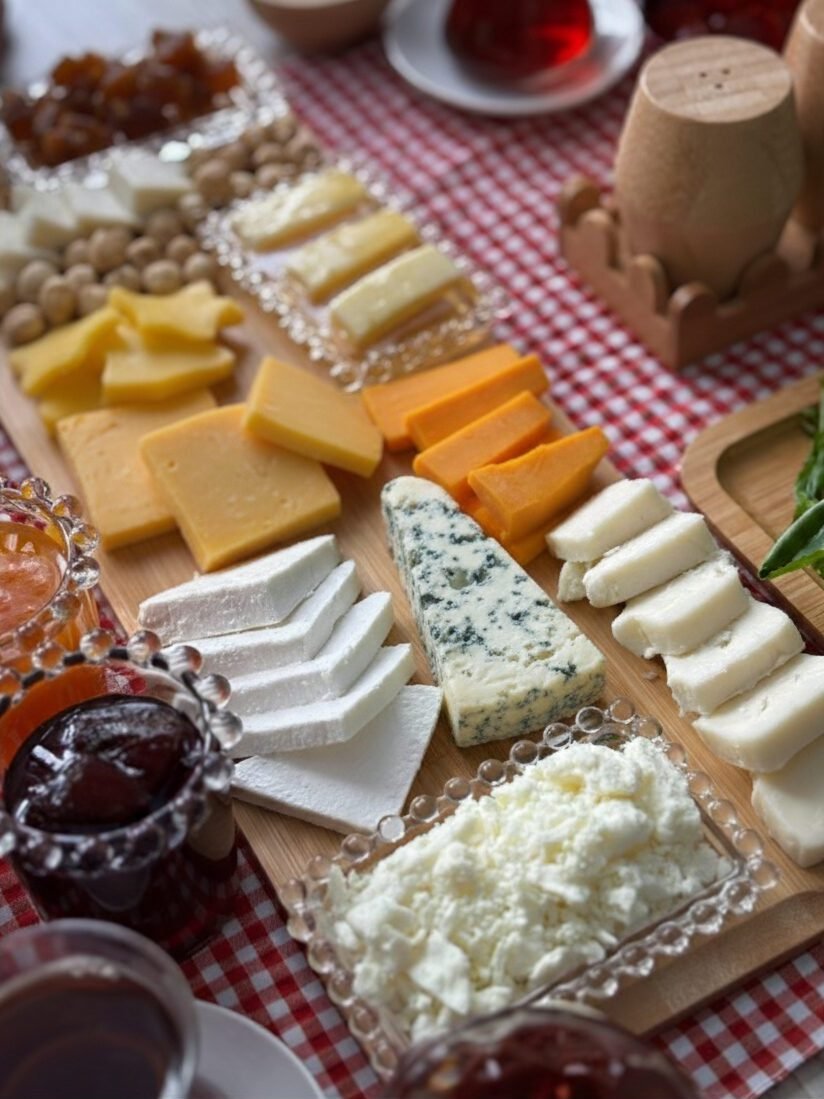
Pu-erh with Aged Cheddar
The sharp and nutty flavor of aged cheddar matches the earthy notes in ripe Pu-erh tea.
Ripe Pu-erh, with its smooth texture and fermented complexity, brings out extra layers in the cheese. Tannins from the tea clean your palate between bites and cut through the richness of aged cheddar.
This partnership lets you enjoy both bold elements without either one overpowering your senses.
Aged cheddar often boasts deep, savory tastes that demand a strong partner. The earthy aroma of Pu-erh rises to meet these flavors, enhancing every bite and sip.
Many tea experts recommend this pairing because it balances intensity while adding depth to each mouthful. Pairing rich foods like aged cheeses with Pu-erh can truly elevate an afternoon snack or evening tasting board.
Blue cheese delivers another experience worth exploring alongside Pu-erh’s complex character.
Pu-erh with Blue Cheese
Blue cheeses like Roquefort and Stilton create a powerful pairing with Pu-erh tea.
Both the cheese and aged Pu-erh offer intense flavors, so their union highlights depth without either one overpowering the other. The earthy richness of Pu-erh enhances the tangy bite of blue cheese, drawing attention to both its creamy saltiness and savory complexity.
Start with small portions to taste how the flavors interact for your palate.
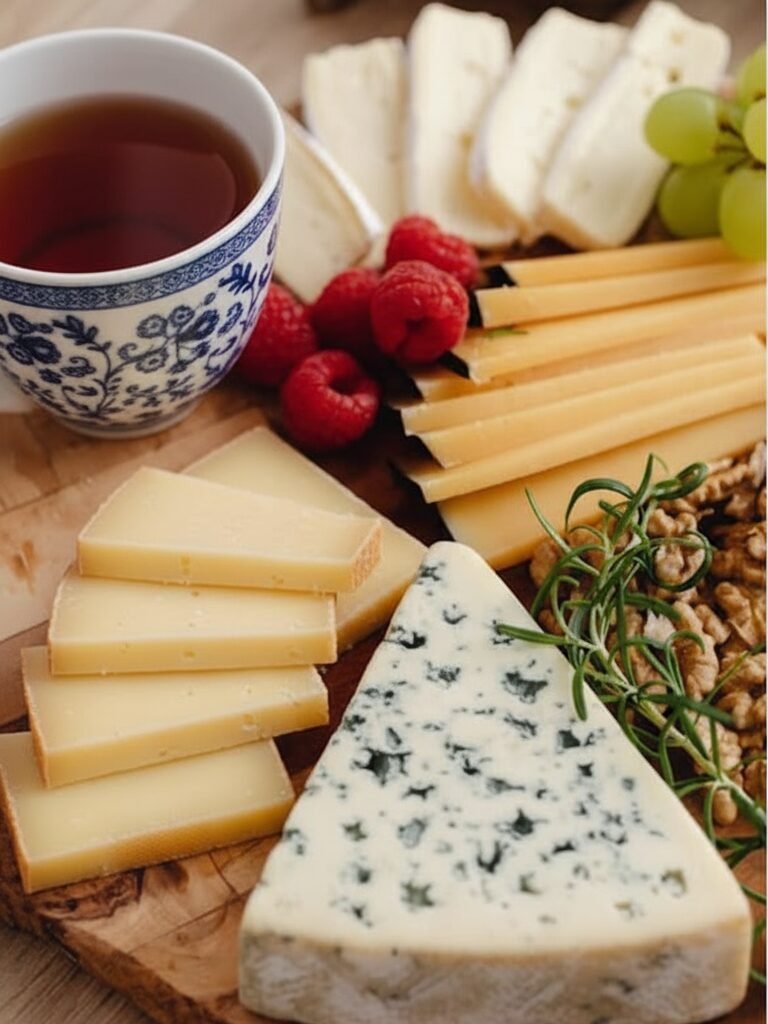
Some sips pull forward more sweetness from the tea, while others amplify the funkiness in the cheese. Serving aged Pu-erh works especially well since its fermented profile blends seamlessly with strong cheeses.
This match suits those who enjoy bold flavor experiences at gatherings or want to experiment beyond traditional wine pairings.
Pu-erh with Gouda
Switching from blue cheese’s tang, Gouda offers a different style of pairing with Pu-erh.
Aged Gouda brings nutty and caramelized flavors that highlight the earthy and smooth qualities of ripe Pu-erh tea. Together, they create a satisfying match for anyone who enjoys strong cheese and dark fermented tea.
Small portions work best to balance both profiles without letting one overpower the other.
Many people discover that this pairing draws out the richness found in each. The creamy depth of aged Gouda meets the mellow earthiness of Pu-erh, making every bite and sip feel fuller.
This combination works especially well if you already enjoy the richness of chocolate or have tasted similar robust teas.
What Desserts Complement Pu-erh Tea?
Pu-erh tea creates a smooth balance when you pair it with desserts that highlight the richness of the chocolate or accentuate nutty flavors.
You can discover bold new tastes by exploring which sweet treats lift its earthy notes.
Pu-erh with Dark Chocolate
Aged Pu-erh tea pairs best with dark chocolate that contains at least 70% cocoa.

The richness of the chocolate brings out the earthy and woody notes in the tea, creating a full-bodied match. Cocoa’s slight bitterness harmonizes with Pu-erh’s complex flavors.
As you enjoy both together, each bite and sip reveal layered aromas that linger on your tongue. This combination often surprises those tasting it for the first time.
Ripe Pu-erh works especially well with chocolates that include fruit or nut inclusions such as dried cherries or roasted hazelnuts.
The dense character of ripe Pu-erh supports these extra flavors while balancing sweetness and acidity found in flavored chocolates. For someone who likes ganache or creamy chocolate truffles, raw Pu-erh can provide a striking counterpoint through its brighter tannins and subtle sharpness.
Many experts recommend pairing this duo after a meal to highlight both the digestive properties of the tea and the luxury of fine dessert choices like dark chocolate.
Pu-erh with Caramel and Toffee
While dark chocolate highlights the earthy side of Pu-erh, caramel and toffee desserts shine with its sweet, molasses-like notes.

Rich French canelés or chewy caramelized puddings create memorable pairings, especially when you select aged Pu-erh teas that develop subtle sweetness over time.
Pairing Pu-erh with caramel treats brings out the tea’s depth and balances sugary flavors. The earthy body of the tea stands up to sticky toffees and enhances their buttery richness.
Many Chinese teahouses also recommends pairing dim sum finished with golden syrup or brown sugar for a satisfying end to your meal.
Pu-erh with Nut-Based Desserts
Nut-based desserts such as walnut cookies, pecan pie, and almond biscotti enhance Pu-erh’s natural nutty undertones.
The tea’s earthy profile balances the sweet richness of these baked treats, especially when you brew it at higher temperatures for a deeper flavor.
Pairing Pu-erh with less-sweet nut pastries highlights both their textures and flavors. Steeping the tea for a shorter time preserves its smoother notes, which works well with light almond-based desserts.
Next, explore how timing affects enjoying Pu-erh as a digestive tea during meals.
When Should You Drink Pu-erh with Meals?
You can enjoy Pu-erh tea with meals any time you want a bold, digestive boost.
Read more to discover how experts recommends pairing the dim sum and other dishes for maximum flavor.
Pu-erh as a Digestive Tea
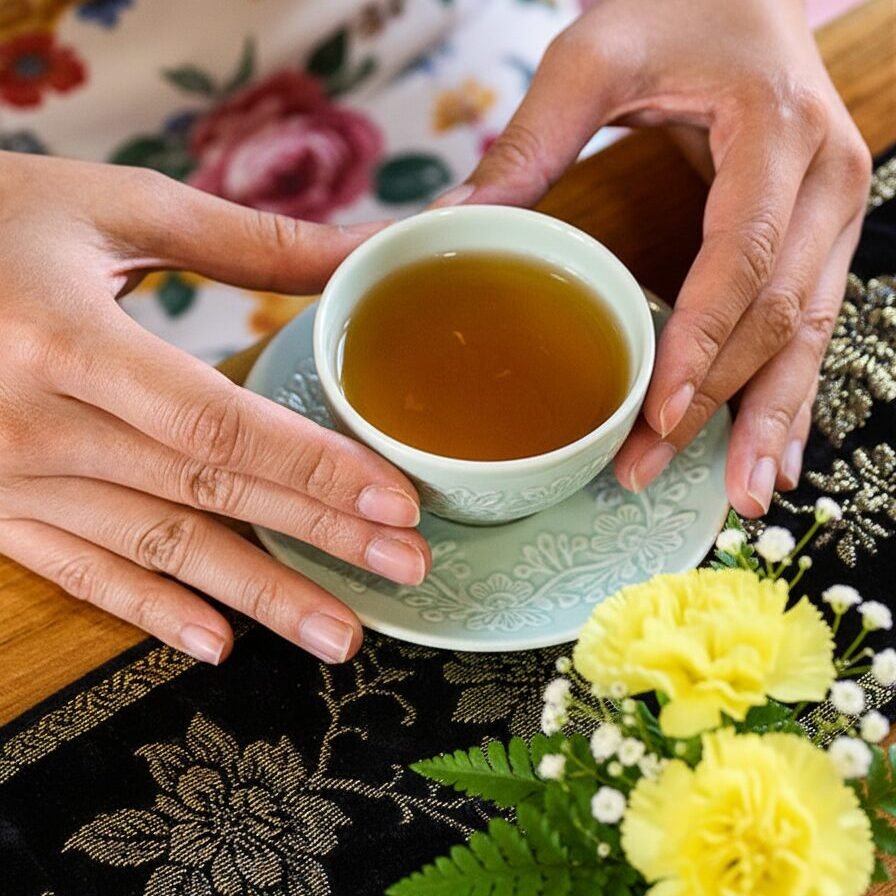
Pu-erh’s fermented nature helps the body digest rich foods, particularly after meals high in oil or spice.
Many tea drinkers recommend pairing the dim sum with Pu-erh for this very reason. Its cooling effect calms the stomach and can provide relief after hearty dishes like roasted meats or belly pork.
Drinkers worldwide notice how its earthy flavor softens greasy sensations on the palate.
Traditionally, people in Yunnan province sip Pu-erh during and after feasts to help digestion.
The tea contains compounds produced by fermentation that aid gut health and may support efficient breakdown of nutrients. Scientific studies suggest these properties can enhance umami flavors while reducing heaviness from fatty foods.
Chinese households often serve ripe Pu-erh at family banquets, using it as both a delicious beverage and gentle digestive aid. Next, explore when is the best time to enjoy Pu-erh with your meals for maximum benefit.
Best Times to Enjoy Pu-erh
Many people appreciate Pu-erh as a digestive tea after hearty meals, but its benefits stretch beyond digestion.
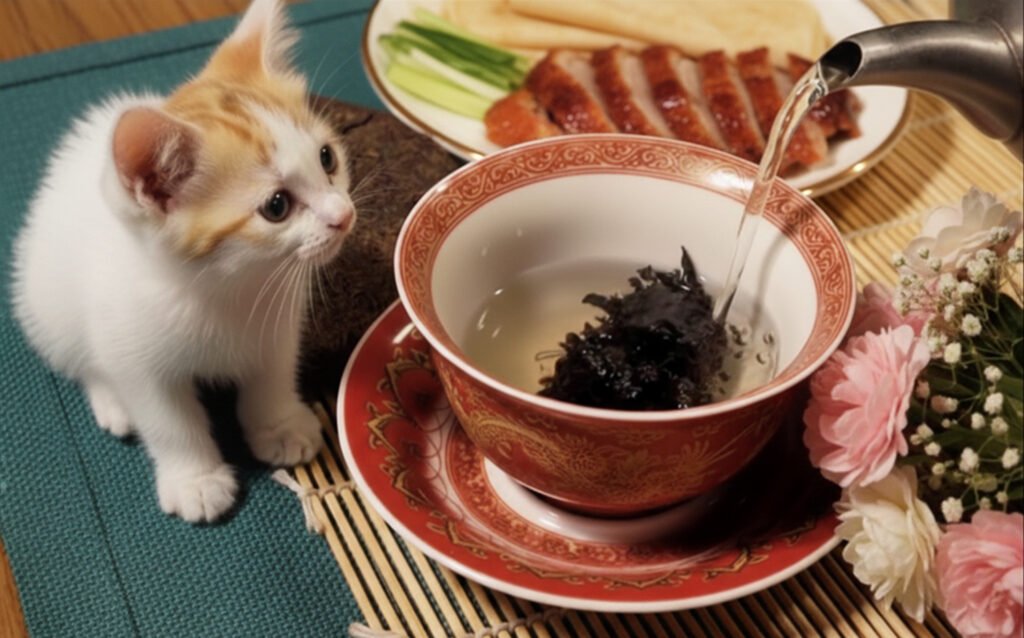
Most drinkers find mid-morning or afternoon to be ideal for enjoying a cup of Pu-erh, thanks to its moderate caffeine level of about 60 to 70 mg per serving. This energizing boost keeps focus sharp without overwhelming the senses.
Tea enthusiasts also use Pu-erh’s soothing properties for relaxation and relief from minor aches during work breaks or study sessions. These times allow both beginners and seasoned tea lovers to savor the earthy notes and complex flavors at their peak.
Embracing Pu-erh’s Pairing Power
Pu-erh tea brings bold flavors and endless pairing possibilities to your table.
It complements everything from fatty meats to sweet desserts, transforming each bite and sip. Explore different styles of Pu-erh with your favorite foods to see what works best for you.
This guide encourages you to discover new combinations that highlight the unique character of this aged Chinese tea.
Enjoy the journey into thoughtful food and Pu-erh pairings that delight both palate and mind.
FAQs
1. Why is Pu-erh often served with rich, fatty meals?
Pu-erh’s unique microbial fermentation gives it a deep, earthy flavor and prized digestive properties. It’s traditionally used to help the body digest and metabolize fats, which is why it’s the perfect tea to cut through the richness of oily foods like dim sum, pork belly, or roasted duck.
2. Do I need to rinse Pu-erh before brewing?
Yes, the article notes that experts recommend discarding the first brew (also known as a rinse). This simple step helps to “awaken” the leaves, remove any storage dust or debris, and can help reduce potential mycotoxins.
3. Which foods pair best with Ripe (Shou) Pu-erh?
Ripe (shou) Pu-erh is very earthy, smooth, and never bitter, making it ideal for the richest foods. Pair it with oily dim sum, fried foods, roasted meats like pork belly and duck, and aged cheeses like cheddar or Gouda.
4. Which foods pair best with Raw (Sheng) Pu-erh?
Raw (sheng) Pu-erh is versatile. Young raw Pu-erh has a fresh astringency that pairs well with spicy cuisines (like Indian curry), grilled seafood, and oily dim sum. Older raw Pu-erh has the depth to pair with aged cheeses (like cheddar) and dark chocolate.
5. What kinds of cheese pair well with Pu-erh?
Pu-erh is excellent with strong, aged cheeses. Its earthy tannins cut through the fat and complement the complex flavors of aged cheddar, Gouda, and even bold blue cheese.
6. Can I drink aged Pu-erh with desserts?
Yes, aged Pu-erh is a perfect match for rich desserts. Its smooth, earthy notes balance the sweetness. It is especially good with dark chocolate (70% cocoa or higher), nut-based pastries (like walnut cookies or pecan pie), and caramel or toffee treats.
7. Should I consider the brewing strength when matching Pu-erh with meals?
Definitely. For delicate meals like steamed fish, a quick 15-second infusion is best. For very rich, heavy dishes like roasted meats or strong cheese, extend the brew to 30-45 seconds to create a stronger tea that can stand up to the bold flavors.
References
- https://teajtea.com/blogs/palates-and-pairings/food-pair-with-puerh-tea?srsltid=AfmBOoqGaFSNE9w7SdAWRunaOxf1HaOrHKw0E-3_ZNBNWjjjSAiYnhYw (2023-11-16)
- https://www.sciencedirect.com/science/article/pii/S002364382500492X
- https://pmc.ncbi.nlm.nih.gov/articles/PMC4918958/
- https://cspuerh.com/blogs/tea-101/how-to-pair-pu-erh-tea-with-different-types-of-food-and-desserts?srsltid=AfmBOoqgVvQlHylX8OGBFzSlepkTvxQy5hJF3InTdIBa9QpJ0OgARQdk (2025-03-11)
- https://orientalteabox.com/blogs/news/pairing-pu-erh-tea-with-food-best-combos-for-every-meal?srsltid=AfmBOooALCD4ycY68Th_iLAp1ldueSf-FZvckoq0QGGeXfnKMbN7nQRO
- https://cspuerh.com/blogs/tea-101/how-to-pair-pu-erh-tea-with-different-types-of-food-and-desserts?srsltid=AfmBOopp5QdNcpuyiyLxCNGFX3ZkVBQhKS8WJ-QHR6ml2L8OTXMO6GLf (2025-03-11)
- https://orientalteabox.com/blogs/news/pairing-pu-erh-tea-with-food-best-combos-for-every-meal?srsltid=AfmBOoqqfw6ekF7iXnomK1NUwzH80lLJprfTQ0xYXzPROgOf-dVKTLUw
- https://orientalteabox.com/blogs/news/pairing-pu-erh-tea-with-food-best-combos-for-every-meal?srsltid=AfmBOoquqnClYBzyWAC7Mbkj8_I8Up2cdJuE9-2CdIpvZBPl_yjtmHI-
- https://orientalteabox.com/blogs/news/pairing-pu-erh-tea-with-food-best-combos-for-every-meal?srsltid=AfmBOorwR9RR2h5Q5W_fqnFFh4puvMZ2A7PI5YnuuX1Iy2blCiYeaEOl
- https://orientalteabox.com/blogs/news/pairing-pu-erh-tea-with-food-best-combos-for-every-meal?srsltid=AfmBOorviatp2oIvcoaHI40M8Y7fVFmLuHq8tvQT_MGT7HzLqb6OMTGs
- https://teajtea.com/blogs/palates-and-pairings/food-pair-with-puerh-tea?srsltid=AfmBOopfwpdRTW3mxcTFoKFLelLDSxCm68LR1lamDQQ5zaJo9UMdFKlG (2023-11-16)
- https://orientalteabox.com/blogs/news/pairing-pu-erh-tea-with-food-best-combos-for-every-meal?srsltid=AfmBOoqwy5eKauW_ZquFnDeJ6HH91qoRMAsJsnbQE-B8vwUWICswe7YP
- https://orientalteabox.com/blogs/news/pairing-pu-erh-tea-with-food-best-combos-for-every-meal?srsltid=AfmBOor92hYcHY_eikMg-vUoWQ16xFh6fd2wEqwY46IpVV3oaOw8onbd
- https://orientalteabox.com/blogs/news/pairing-pu-erh-tea-with-food-best-combos-for-every-meal?srsltid=AfmBOooVHJfqu2w69Elw64PUWLhENMxdwXfqGuNhnC4SHtc7sZicqN9W
- https://orientaleaf.com/blogs/tea-101/chinese-tea-food-pairing-guide?srsltid=AfmBOor7YHPTjW1gm2q6BOcKTSZwCXazgAFZnAMNylhr7cG8aVchHojc (2025-09-13)
- https://orientalteabox.com/blogs/news/pairing-pu-erh-tea-with-food-best-combos-for-every-meal?srsltid=AfmBOoo0LHM1YYqyYZA0sP7Um2FYLjRsI_VSC5ZK7sZHCjlGG-RsInDU
- https://orientaleaf.com/blogs/tea-101/chinese-tea-food-pairing-guide?srsltid=AfmBOoqpYwmCLpCgNPqbCU0_MZkVHm8b73NWyTDT88BQMBNTxGAZ1ivY (2025-09-13)
- https://orientalteabox.com/blogs/news/pairing-pu-erh-tea-with-food-best-combos-for-every-meal?srsltid=AfmBOoomGL8yoACAugmr227EbRQ7wajWUuoJm8mwkJfsZsIcZMSEkV8p
- https://orientalteabox.com/blogs/news/pairing-pu-erh-tea-with-food-best-combos-for-every-meal?srsltid=AfmBOoqM1_TRJM4hfW1WL-8E348CcUhJMKUhrhfTIJx3afqYrINQy0cd
- https://orientalteabox.com/blogs/news/pairing-pu-erh-tea-with-food-best-combos-for-every-meal?srsltid=AfmBOooc0xa1EF5LgGq45NxTbs7MUuUl7ysaO2rtSMBxRPOq398-IC8I
- https://teajtea.com/blogs/palates-and-pairings/food-pair-with-puerh-tea?srsltid=AfmBOoppezITX3ApwWT8rB_sape8azcotKDYEWZH1P2yhDKWIS2HPJ5D (2023-11-16)
- https://cspuerh.com/blogs/tea-101/how-to-pair-pu-erh-tea-with-different-types-of-food-and-desserts?srsltid=AfmBOoqS1JYGb_fwx1_w3hHu5Ni8T2r896VIQwXpcAk5cuypO9DprpCb (2025-03-11)
- https://cspuerh.com/blogs/tea-101/how-to-pair-pu-erh-tea-with-different-types-of-food-and-desserts?srsltid=AfmBOoq_liFAFE42joBIPP-LDGGkQm-m04-ZEzH0SsmHo3jIfojB-f_3 (2025-03-11)
- https://cspuerh.com/blogs/tea-101/how-to-pair-pu-erh-tea-with-different-types-of-food-and-desserts?srsltid=AfmBOop6bnrVvcgL-Ie0GGta1fYcT3W6pRCq-cSy21y5aAKz7a9gGCry (2025-03-11)
- https://cspuerh.com/blogs/tea-101/how-to-pair-pu-erh-tea-with-different-types-of-food-and-desserts?srsltid=AfmBOorRso2CogMza-T1lcereWICMiJyu0ihEyhzUG2zIYuKYAQMx8mg (2025-03-11)
- https://orientalteabox.com/blogs/news/pairing-pu-erh-tea-with-food-best-combos-for-every-meal?srsltid=AfmBOoqKZteOWecY_zJyLmEHCs9XhmoHpBTva4H8vEwfoXGsFKyuMoXb
- https://orientalteabox.com/blogs/news/pairing-pu-erh-tea-with-food-best-combos-for-every-meal?srsltid=AfmBOopWt7t9Yv1O__AQy06Emh37rxICdZyfyVuGsa3nsCA1g3906Li6




